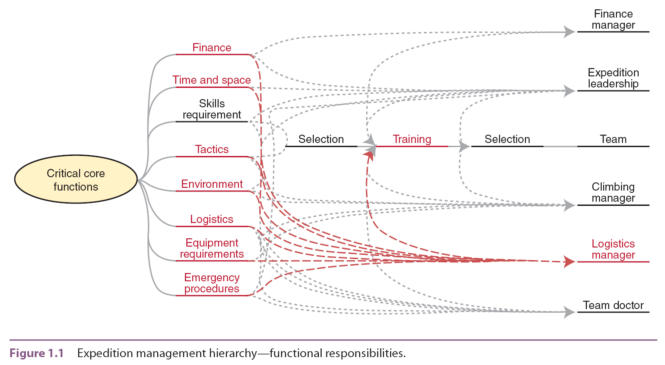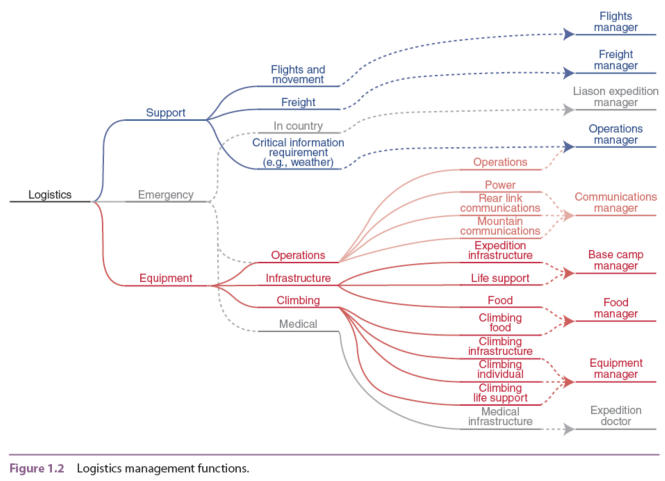Logistics play a central role in expeditions
This is an excerpt from Mountaineering by Carlton Cooke,Dave Bunting,John O'Hara.
Role of Logistics in the Expedition
To understand how logistics fits into the expedition, it is necessary to discuss where it lies in the higher management functions. On a complicated expedition such as ours, it is impossible for one person to deal with every area. Therefore, large expeditions are often divided into hierarchical areas or functions. In our case, this hierarchy enabled the overall capability of the expedition. Each hierarchical function had a manager who was responsible for delivering that function to the expedition. Figure 1.1 shows how the logistical element fitted in with the overall expedition hierarchy. The whole logistics effort was too large for one person to manage, so we divided this effort further into subfunctions. Figure 1.2 shows how these individual areas were linked.


The lines of communication for our expedition were extensive. Logistics had a central role within the expedition hierarchy and for those who were delivering the details that would make the expedition work. Just about every decision made in any of the other functions and areas influenced the logistics plan. As such, it is fundamental to expedition success to get logistics right. It is also important to ensure that the team works together efficiently. Finally, expeditions by nature involve a group of people from various occupations and geographic locations. Most of the necessary teamwork has to be conducted at a distance. We rarely met as an entire team during the preparation phase of the expedition, and therefore communicating intent to the team became a serious issue.
Logistics should be considered as a series of bases and dumps placed in such a way as to enable the overall effort of the expedition. Careful consideration should be made as to where logistical command and control should sit amongst these operational bases during various expedition phases. This is likely to vary during the course of the expedition.
For our expedition, we had two strategic bases—one in the United Kingdom, where we prepared and deployed all-out logistical effort, and one in Nepal, where all the logistical effort was consolidated in theatre. Then, we established three operational bases—the camp where vehicle transport terminated (Road Head Camp, or RHC), the location where the yak lift had to stop (Tilman's Camp, or TC), and the camp where the heavy portage (mostly Sherpas) had to stop (Camp 1 at the foot of the mountain, where the climbing began). Resources were then deployed in a set order through the operational bases to allow the tactical effort of climbing the mountain to begin without pause. There were an additional four tactical camps.
Learn more about Mountaineering.
More Excerpts From MountaineeringSHOP

Get the latest insights with regular newsletters, plus periodic product information and special insider offers.
JOIN NOW


